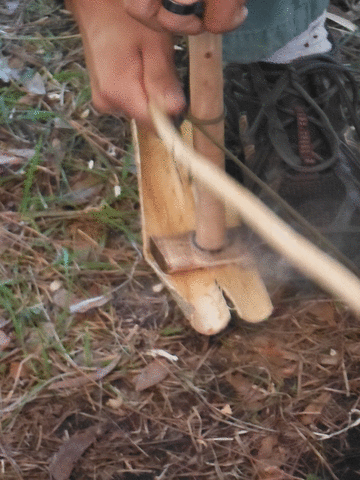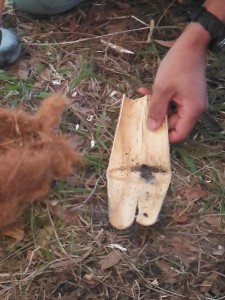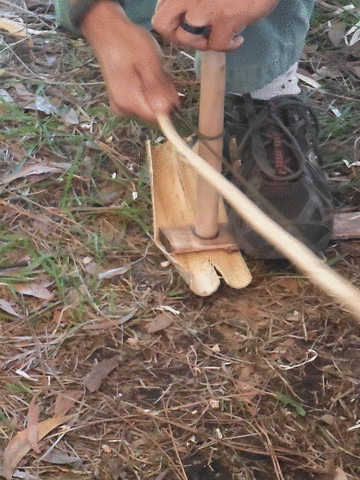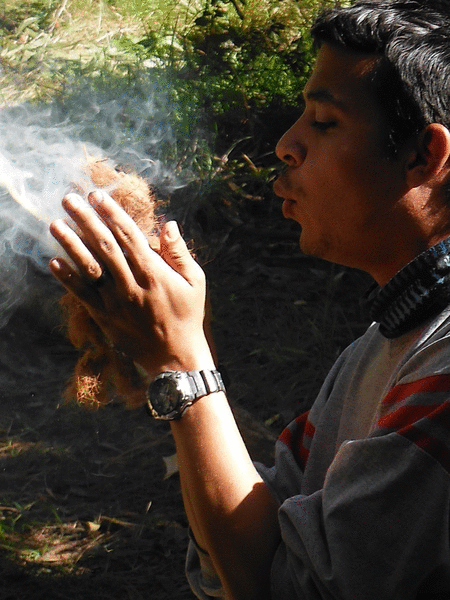(Note: This is NOT so much a “How-To” as much as a narrative of “How It Went”. While you can get the general idea of how to use a bow drill to start a fire by reading this, many other sources offer more detailed information. Better still, find someone that already knows how and have them show you. And once you get it, pass on the skill to someone else.)
Last weekend at the Green Earth Survival School’s Primitive Skills class, Hank walked everyone through the process of starting a fire with a bow drill. I’ve personally seen Hank get an ember with a bow drill in about 12 seconds. He immediately apologized for taking so long, and MEANT it! But he’s had LOTS of practice….and lucky for his classes, he is also a great instructor.
Hank started with collecting materials and constructing a bow drill. The five parts to the bow drill set are the bow, the string, the spindle, the foot board, and the handhold. He went on to explain what types of wood that work best for each part. For Florida, its hard to beat a willow foot board and a willow spindle, though other softwoods also can work. Whatever wood is used the spindle and foot board need to be as dry as possible. Hank is also partial to a smooth rock or seashell for the handhold, or top pivot. Whatever is used for a handhold should be as smooth as possible to limit friction. You want the friction at the bottom, not the top.
It just so happens that I had run across a dead willow of decent size, so I had cut off about a two foot section about as big around as my calf. I then took it to my bandsaw and cut it into 1/2 inch thick boards and placed it in my attic to dry. Six months ago. Plenty of time to dry out. (The other assistant instructor, Amanda, called me a brown-noser for giving Hank a pile of well-dried willow boards. I thought it was simply good planning on my part. PFFT!)
Good quality tools take time and patience. Hank states that, while it is an option in an emergency and CAN be made to work with enough skill and effort, a bow drill for making fire was a long-term option, not something you can always put together in a few hours and expect a decent result every time. Those that used bow drills or hand drills relied on them for every day use, and were able to forage for the materials on a daily basis. Seldom did primitive man NOT have a decent method to build a fire with him at all times, be it bow drill, hand drill, flint and steel (or a 12v battery and some steel wool).
The particular bow drill that Hank carries is in a relatively dry carrying container, and is kept out of the dampness and away from moisture in order to keep the wood in optimal condition for starting a fire via friction. Once a working bow drill is assembled, it is guarded as though your life depended on it…because back in the day..it did.
Back to the class…Hank, having stepped us through the construction went on to explain the method used. A hard, smooth spindle on top in your dominant hand. Squatting, lock the base of you thumb against your knee. With the bow string wrapped around the spindle, apply steady downward pressure on the spindle into the notch on the foot board.
Dean, one of the students, jumped at the chance to try.
Increase the pace.
Bear down more.
Go faster.

More pressure.
More speed.
When you start to feel light-headed and about to pass out,
GO FASTER.
MORE PRESSURE.
As you start to black out, give it one last burst of speed and pressure…

..then stop,
gently remove the spindle from the board,
transfer the ember to your tinder bundle,
and (here is the funny part) gently blow into the tinder
(as if you have any breath left in you),
gradually increasing.
This pushes oxygen into the ember, increasing its temperature, igniting the nearby bundle.
Not many students get an ember the first try. Hank says that women tend to have better luck…it seems they can follow directions better! However, Dean here jumped in having never started a bow drill fire before, and with only limited coaching while sweating up a storm, was able to create fire from his very own sweat, grit, and determination. Thanks for the effort, Dean!
In this day and age, so few of us can fully comprehend the sheer ecstasy of proving to yourself that you can overcome the elements with your mind and your skills.
We are not the strongest species, nor the fastest. But we are able to adapt, and have a superior intellect. This gives us the ability to master our environment.
Creating fire is the ultimate first step in that journey of self reliance. Tom Hanks NAILED it in “Castaway“. Watch his look of disbelief when he achieves his first whisp of smoke…then watch as he realizes that he CAN overcome his situation:
Fire by itself is a thing of power and beauty, full of magic and wonder. Creating fire by any method offers us a glimpse of that magic we lost over the ages.
Learn to make fire via a primitive method, and you’ll understand what I’m talking about.
Peace,
db


